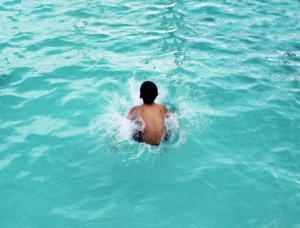Ear infections are the most common illness in children, and if you’ve been unlucky enough to have a child experience one, you know they are NO FUN. Not for your child and not for mom and dad! Many parents wonder what ear infections mean for swimming – can your child still go to swim class? Should they wear ear plugs to prevent infections? 
Here is some information about ear infections and “swimmer’s ear” and what you can do to help prevent your child from getting one.
Swimmer’s Ear
Swimmer’s Ear is an outer ear infection that typically affects older children and adults that are in the water frequently. There are a variety of factors that can cause an outer ear infection, such as warm/humid air, warm water, bacteria or frequent swimming. When moisture gets trapped in the ear canal, bacteria multiplies, causing an infection. If your child has swimmer’s ear, they will most likely need ear drops.
These ear infections can be very painful and your swimmer will likely want to take 7-10 days off from swimming, or wait until a doctor says it’s okay. 
Inner Ear Infections
Middle/Inner ear infections often show up after a child has been sick with a cold or throat infection. When the child’s inner ear tubes are unable to drain properly, fluid builds up in the middle ear and can become infected. Symptoms might include pain, fever, irritability or ear discharge. These can be painful and doctors will often prescribe antibiotics to help cure the infection.
These types of ear infections are NOT contagious, although the colds that cause them are. There is no restriction on swimming with a middle/inner ear infection (other than deep dives). If your child has an inner ear infection, they can still enjoy our warm water – although if you are concerned, it’s always best to check with your child’s pediatrician!
Tips for Preventing Swimmer’s Ear:
Some children are more prone to infections, but there are a few simple tips you can use to help prevent Outer Ear Infections (AKA Swimmer’s Ear).
- Dry your child’s ears after swim. Use a towel or have your child tilt their head and shake the water out of their ears.
- Use ear plugs or a swim cap to cover and protect the ears
- Don’t put anything in your child’s ear, including Q-tips or fingers


